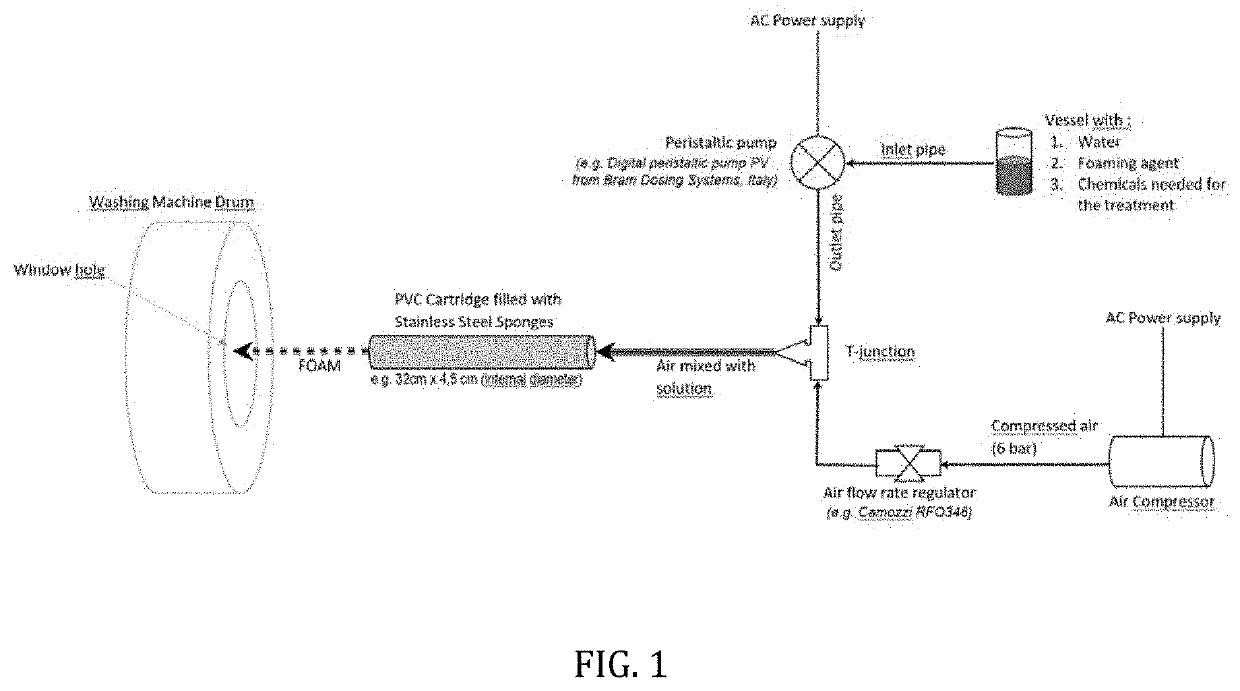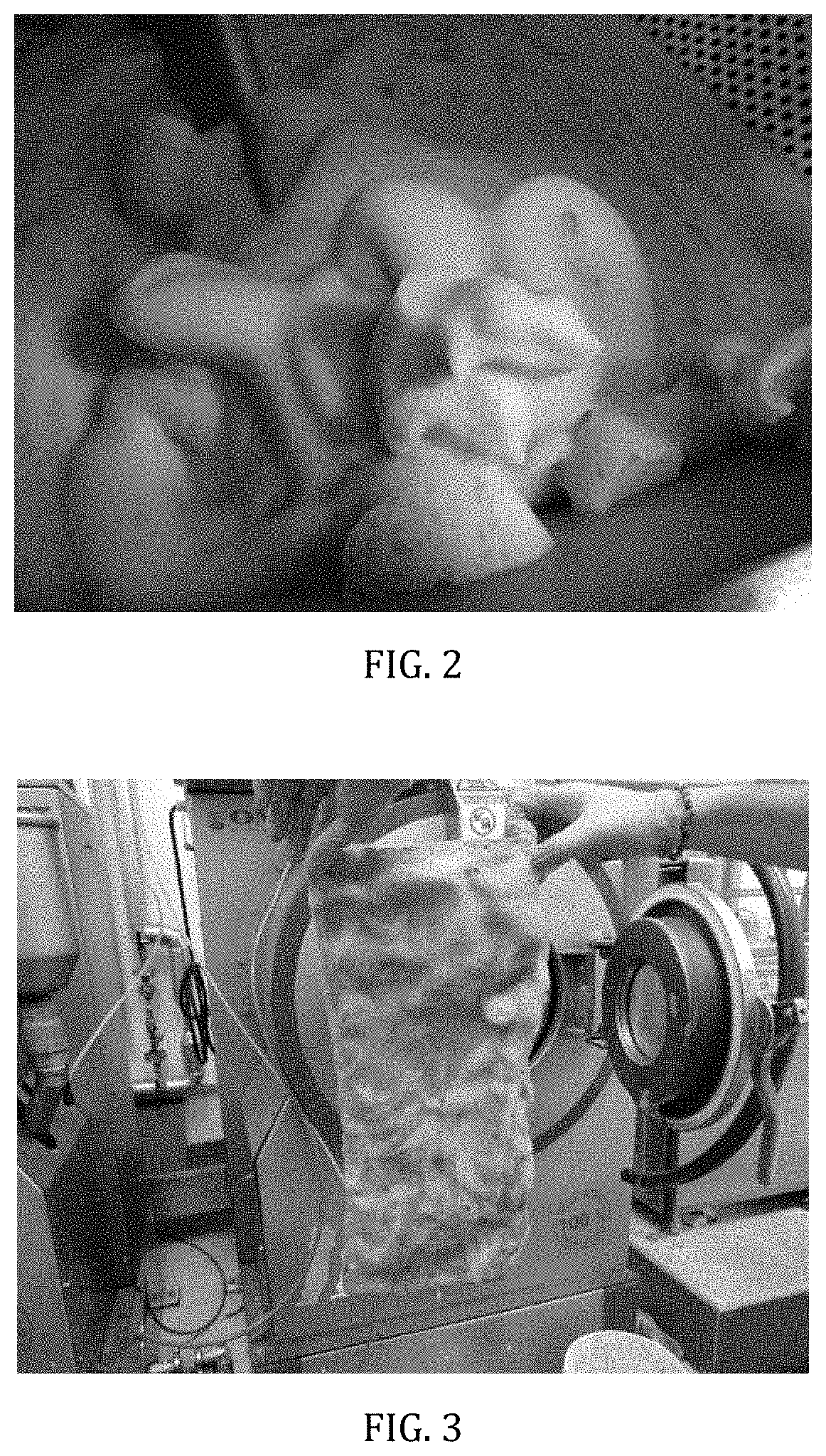Methods of treating textiles with foam and related processes
- Summary
- Abstract
- Description
- Claims
- Application Information
AI Technical Summary
Benefits of technology
Problems solved by technology
Method used
Image
Examples
example 1
ed Denim
[0039]Materials and Methods:
[0040]Table 3 contains the materials used throughout the experiment.
TABLE 3Materials usedMaterialSupplierModelLot #Laser equipmentSei Laser, ItalyFlexi denim—Foam generating moduleKemin Textiles s.r.l., San MarinoPrototype (See FIG. 1)—Washing MachineOMI, ItalyLCF 16 ST—Denim garment (co 67%; polyAdvance Denim, ChinaQA149L5-5 Deep—22%; vis 9.5%; ly 1.5%)blue LATB 710Kemin Textiles s.r.l., San Marino—1901117806Fortres GSLKemin Textiles s.r.l., San Marino—1807109646Citric Acid AnhydrousKemin Textiles s.r.l., San Marino—1812111252Foaming Agent #1Kemin Textiles s.r.l., San Marino——Tween 20Industria Chimica Panzeri, Italy8693Tween 80Industria Chimica Panzeri, Italy37061Special White LTKemin Textiles s.r.l., San Marino—1901118677Hydrogen Peroxide 30%Garmon, San Marino—1904083
[0041]Denim garments, five garment samples at 700 grams each, were treated with laser equipment (mode 01hs, resolution: 150.000 dpi on X-axis; 9.000 dpi on Y-axis) to mimic visual e...
example 2
with NaOCl and Foam on Stonewashed Denim
[0044]Materials and Methods:
[0045]Table 5 contains the materials used throughout the experiment.
TABLE 5Materials usedMaterialSupplierModelLot #Laser equipmentSei Laser, ItalyFlexi denim—Foam generating moduleKemin Textiles s.r.l., San MarinoPrototype (See FIG. 1)—Washing MachineOMI, ItalyLCF 16 ST—Denim garment (co 67%; polyAdvance Denim, ChinaQA149L5-5 Deep22%; vis 9.5%; ly 1.5%)blue LATB 710Kemin Textiles s.r.l., San Marino—1901117806Fortres GSLKemin Textiles s.r.l., San Marino—1807109646Citric Acid AnhydrousKemin Textiles s.r.l., San Marino—1812111252Foaming Agent #1Kemin Textiles s.r.l., San Marino——Foaming Agent #2Kemin Textiles s.r.l., San Marino—1901115746Tween 20Industria Chimica Panzeri, Italy8693Tween 80Industria Chimica Panzeri, Italy37061Special White LTKemin Textiles s.r.l., San Marino—1901118677Hydrogen Peroxide 30%Garmon, San Marino—1904083Sodium Hypochlorite 14%Garmon, San Marino—B0007829
[0046]Denim garments, five garment sampl...
example 3
with Avol Evanix and Foam
[0049]Materials and Methods:
[0050]Table 7 contains the materials used throughout the experiment.
TABLE 7Materials usedMaterialSupplierModelLot #Laser equipmentSei Laser, ItalyFlexi denim—Foam generating moduleKemin Textiles s.r.l, San MarinoPrototype (See FIG. 1)—Washing MachineOMI, ItalyLCF 16 ST—Tumble dryerLavenda L&TM, ItalyERV77—Denim garment (co 67%; polyAdvance Denim, ChinaQA149L5-5 Deep—22%; vis9.5%; ly 1.5%)blue LAvol EvanixKemin Textiles s.r.l., San Marino—1901100834Booster OWKemin Textiles s.r.l., San Marino—1807112479Foaming Agent #1Kemin Textiles s.r.l, San Marino——Tween 20Industria Chimica Panzeri, Italy8693Tween 80Industria Chimica Panzeri, Italy37061Special White LTKemin Textiles s.r.l, San Marino—1901118677Hydrogen Peroxide 30%Garmon, San Marino—1904083
[0051]Denim garments, five garment samples at 700 grams each, were treated with laser equipment (mode 01hs, resolution: 150.000 dpi on X-axis; 9.000 dpi on Y-axis) to mimic visual effects, such...
PUM
| Property | Measurement | Unit |
|---|---|---|
| Pressure | aaaaa | aaaaa |
| Diameter | aaaaa | aaaaa |
| Length | aaaaa | aaaaa |
Abstract
Description
Claims
Application Information
 Login to View More
Login to View More - Generate Ideas
- Intellectual Property
- Life Sciences
- Materials
- Tech Scout
- Unparalleled Data Quality
- Higher Quality Content
- 60% Fewer Hallucinations
Browse by: Latest US Patents, China's latest patents, Technical Efficacy Thesaurus, Application Domain, Technology Topic, Popular Technical Reports.
© 2025 PatSnap. All rights reserved.Legal|Privacy policy|Modern Slavery Act Transparency Statement|Sitemap|About US| Contact US: help@patsnap.com



